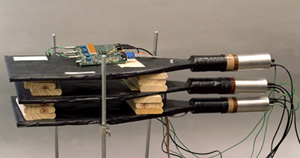What's in the box? In January 2000, Tom Jordan had just finished up a conference in San Diego, where he had presented one of the new cosmic ray detectors to QuarkNet teachers. (Today, these detectors are found in more than 200 high school physics classrooms across the United States.) Jordan, of Fermilab's Education Office, drove to the San Diego airport, preparing to take a red-eye flight back to Chicago. Jordan passed through the metal detector as easily as he had in Chicago before the flight out. But when the box with the cosmic ray detector passed through the x-ray machine on the conveyor belt, the image aroused the security guard’s suspicions. "I thought for a minute about how to explain what it was," says Jordan. "So I said it was a device that detects subatomic particles that move through our atmosphere." Jordan showed the guard the two scintillating plastic counters, phototubes and readout electronics. "Then the guard called up her supervisor on the phone and told him that 'some guy wants to know if he can bring his atmosphere protector on the plane.' But I wasn't going to correct her because I wanted to get home."
Click here to download the pdf version of this article. |







